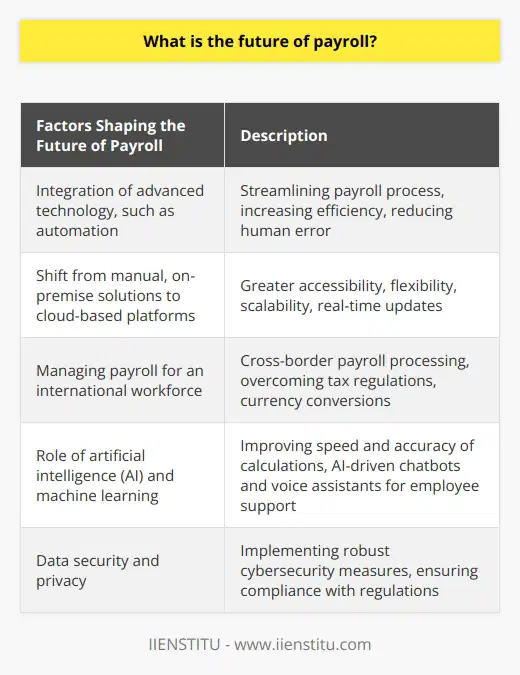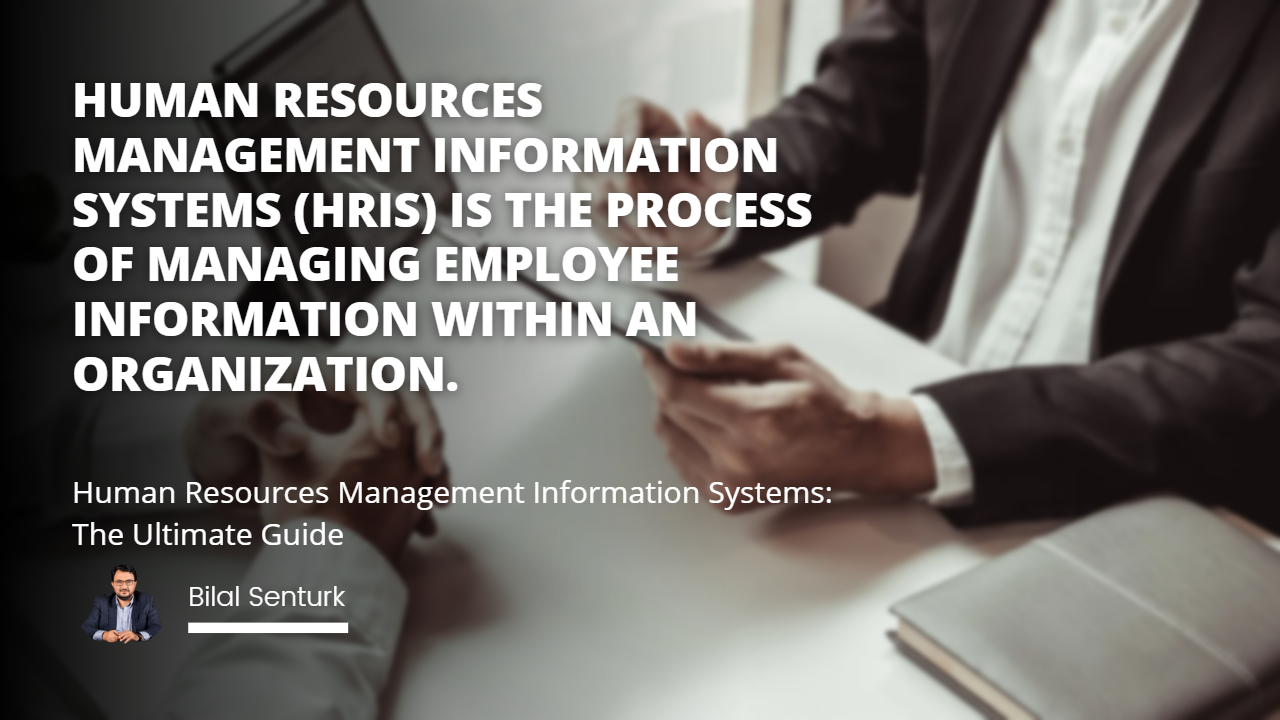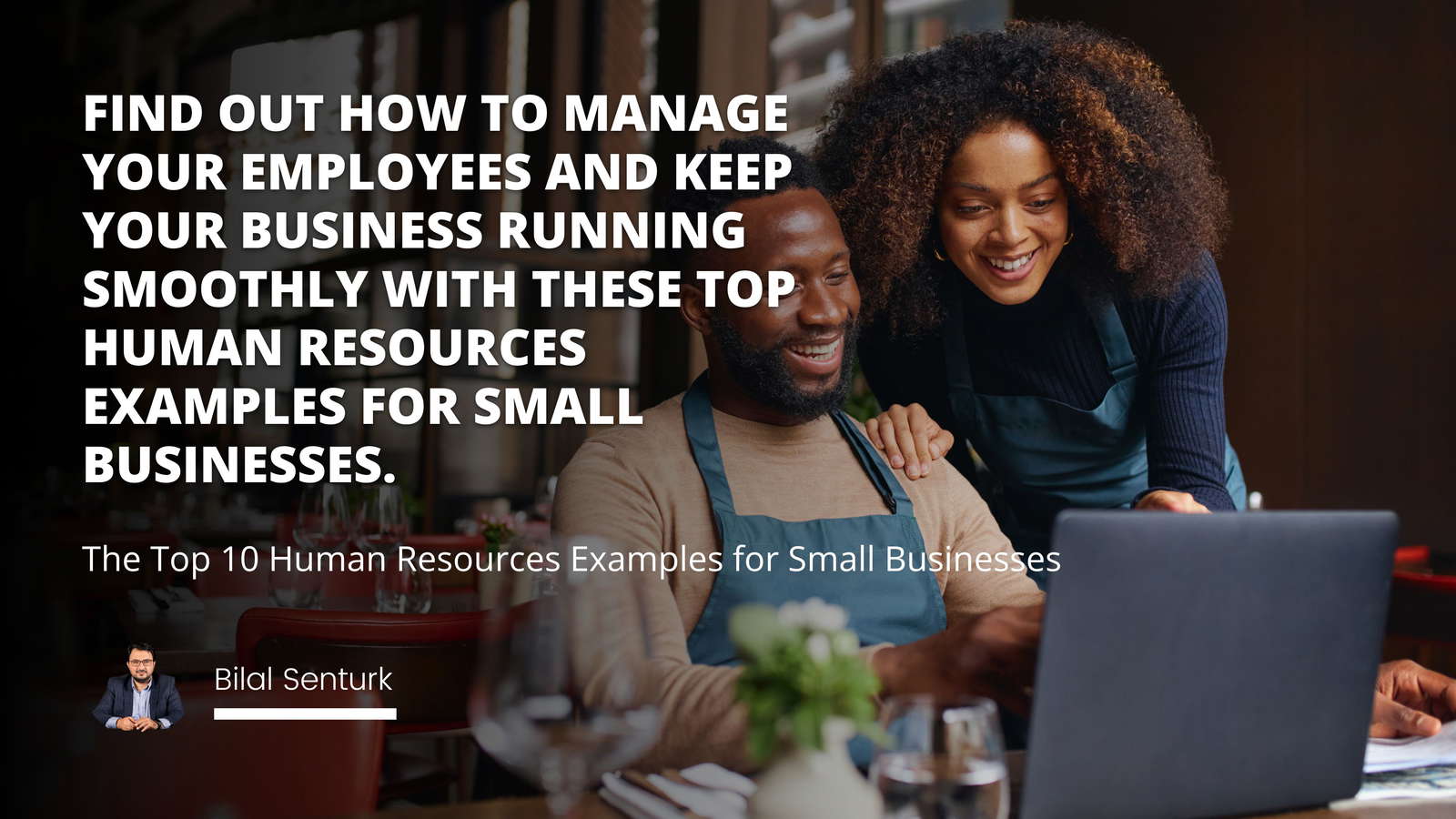
Overview of Payroll Management
Challenges in Payroll Management
Benefits of Payroll Management for Human Resources Development
Strategies for Effective Payroll Management
Future Directions for Payroll Management and Human Resources Development
Overview of Payroll Management
Payroll management is a critical aspect of managing a business. It is a complex process that involves ensuring that employees are paid accurately and on time and managing the associated taxes, deductions, and benefits. This article provides an overview of payroll management, its importance, and its potential for improving business efficiency.
What is Payroll Management?
Payroll management is managing employee wages, deductions, and benefits. It includes tracking employee hours, calculating paychecks, processing tax payments, and ensuring compliance with labor laws. It is essential to running a business, ensuring that employees are paid correctly and all necessary taxes are paid on time.
The Benefits of Payroll Management
Payroll management can provide several benefits to businesses. First, it can help ensure that employees are paid accurately and on time. This can reduce the number of payroll mistakes and minimize the time spent on manual calculations. Additionally, payroll management can help streamline the process of managing employee benefits and deductions, such as health insurance and retirement savings. This can reduce the amount of manual work required and ensure that employees receive the correct benefits.
Furthermore, payroll management can help businesses stay compliant with labor laws. Businesses can avoid costly fines and penalties by tracking employee hours, calculating paychecks, and processing taxes accurately and on time. Additionally, payroll management can help businesses identify and prevent fraud and minimize the risk of employee theft.
Unlocking the Potential of Payroll Management
HR Service Delivery: Optimizing Workforce Value in Modern Businesses
HR Risk Management: Strategies for Optimal Employee Performance
Payroll management can be an effective tool for improving business efficiency. Businesses can save time and reduce costs by automating various aspects of the payroll process. Additionally, by integrating payroll management with other systems, such as accounting and human resources, businesses can gain better visibility into their workforce and expenses.
The first step to unlocking the potential of payroll management is to assess the current process. This will help identify areas that can be improved and automated, such as manual calculations or manual data entry. Additionally, businesses should explore different payroll management solutions, such as cloud-based or software-as-a-service (SaaS).
Once a payroll management solution has been selected, businesses should ensure that they are familiar with the features and capabilities of the system. This will help ensure the system is configured correctly and that all necessary data is collected. Additionally, businesses should ensure that the system is integrated with other systems, such as accounting and human resources, to ensure data is accurately shared between systems.
Payroll management is essential to a business, as it helps ensure that employees are paid accurately and on time. Additionally, payroll management can help businesses comply with labor laws and minimize the risk of employee theft. By automating the payroll process and integrating it with other systems, businesses can unlock the potential of payroll management and improve their overall efficiency.
Challenges in Payroll Management
Payroll management is a critical component of any business, as it requires the accurate and timely payment of wages to employees. However, payroll management can be challenging and is often associated with various potential risks and difficulties.
Challenges
One of the significant challenges in payroll management is ensuring accuracy. Payroll errors can lead to overpayments and underpayments, resulting in financial losses and legal and compliance issues. Additionally, payroll data must be kept up-to-date and updated with any changes in employee status, such as promotions, pay increases, or terminations.
Another challenge is the need to process payroll promptly. This requires a robust system to quickly and accurately process information and meet all applicable legal deadlines. Additionally, it requires handling large volumes of data and generating accurate reports.
Finally, payroll management requires the implementation of adequate security measures. This includes protecting the company's data from unauthorized access and ensuring that employee data is kept confidential and secure.
Strategies for Overcoming Challenges
Businesses should consider implementing a comprehensive payroll management system to address the challenges associated with payroll management. This system should be designed to meet the company's specific needs and tailored to address the specific challenges associated with the company's payroll.
The system should include features such as automated payroll processing, which can improve accuracy and reduce the risk of errors. Additionally, the system should be able to generate reports quickly and accurately to meet legal deadlines.
Finally, the system should incorporate strong security measures to protect the company's data and ensure the confidentiality of employee data. Additionally, the system should be regularly tested and updated to ensure it remains secure and compliant with applicable laws and regulations.
Payroll management can be challenging, but businesses can overcome these challenges by implementing a comprehensive payroll management system. This system should include automated payroll processing, the ability to generate accurate reports quickly, and robust security measures to ensure the confidentiality of employee data. With the right system in place, businesses can unlock the potential of payroll management and ensure accurate and timely payment of wages to their employees.
Benefits of Payroll Management for Human Resources Development
Payroll management is a critical component of human resource development. It is the foundation upon which organizations can accurately and efficiently manage their workforce. This paper will explore the benefits of effective payroll management and why it is an essential component of human resource development.
Improved Accuracy and Efficiency
Payroll management can increase accuracy and efficiency in the payroll process. By automating the payroll process, organizations can reduce errors and save time. Automation also reduces the need for manual data entry, which can help reduce errors and improve accuracy. Additionally, payroll management can streamline the process of issuing paychecks and other employee payments.
Increased Compliance with Regulations
Payroll management can help organizations comply with federal, state, and local regulations. By using payroll management, organizations can ensure that the law pays all employees and that all taxes are accurately calculated and filed. This can help organizations avoid costly fines and penalties.
Improved Employee Satisfaction
Payroll management can also help improve employee satisfaction. By automating the payroll process, organizations can reduce the time spent on payroll activities, which can help improve employee morale and engagement. Additionally, payroll management can help ensure that employees are paid promptly and accurately, which can help increase job satisfaction.
Payroll management is an essential component of human resource development. It can provide several benefits to organizations, such as improved accuracy and efficiency, increased compliance with regulations, and improved employee satisfaction. Therefore, organizations should consider implementing payroll management to maximize the effectiveness of their human resource development efforts.
Strategies for Effective Payroll Management
Payroll management is one of the most important aspects of any business. It is a complex process that requires accurate calculations, timely payments, and data security. For businesses of all sizes, effective payroll management is essential to ensure the organization's financial well-being. This article aims to provide an overview of strategies for effective payroll management.
Automation
One of the most effective strategies for payroll management is automation. Automation eliminates manual data entry and provides an efficient way to manage payroll data. As a result, automated payroll systems can save time, improve accuracy, and reduce costs. Additionally, automated systems provide the ability to quickly generate reports, track employee data, and process payments.
Data Security
Data security is another essential element of payroll management. Data security ensures that payroll data is kept safe from unauthorized access or misuse. In addition, businesses should ensure their payroll data is secure from external threats and data breaches. This includes implementing access control measures, such as two-factor authentication, encrypting data, and using secure software.
Compliance
Compliance is also an essential aspect of payroll management. Businesses must comply with all relevant laws and regulations when managing payroll. This includes understanding and meeting the requirements of local, state, and federal laws and any applicable industry regulations. Businesses should also stay up-to-date on any changes in the law and ensure their payroll processes are compliant.
Analytics
Analytics can also be used to improve payroll management. Businesses can gain insights into their payroll processes by using analytics to identify trends and patterns in payroll data. In addition, Analytics can help businesses identify areas for improvement, such as areas where costs can be reduced or increased productivity.
Payroll management is an essential part of any business. By implementing the strategies outlined in this article, businesses can ensure that their payroll processes are effective and compliant. Automation, data security, compliance, and analytics are essential to successful payroll management. With the right strategies in place, businesses can unlock the potential of their payroll processes.
Future Directions for Payroll Management and Human Resources Development
Payroll management is critical to any human resources or financial management system. With the recent advancements in technology, the potential of payroll management has been further unlocked, leading to more efficient and accurate processes. This article provides an overview of the current status of payroll management, along with the potential for future development in the field.
Trends and Developments
Recent payroll management trends have improved accuracy, efficiency, and cost savings. Automation of the payroll process has led to faster processing times and better accuracy, resulting in fewer errors and more efficient operations. Additionally, cloud-based systems have enabled payroll data to be accessible from any location, allowing for real-time monitoring and quicker decision-making.
Future Directions
Going forward, there are several potential areas of development in payroll management. These include further automation of the payroll process, improved accuracy, auditing capabilities, and integration of payroll management with other systems. Developing predictive analytics and machine learning algorithms could also enable organizations to forecast payroll costs better and plan accordingly. Finally, blockchain technology could improve the security of payroll data and ensure that all transactions are appropriately documented and tracked.
Payroll management is integral to any human resources or financial management system. With the recent advancements in technology, the potential of payroll management has been further unlocked, providing organizations with the opportunity to increase accuracy, efficiency, and cost savings. Going forward, there are several potential areas of development in payroll management that could further improve the overall process.
Payroll management is the key to unlocking a company's potential success.
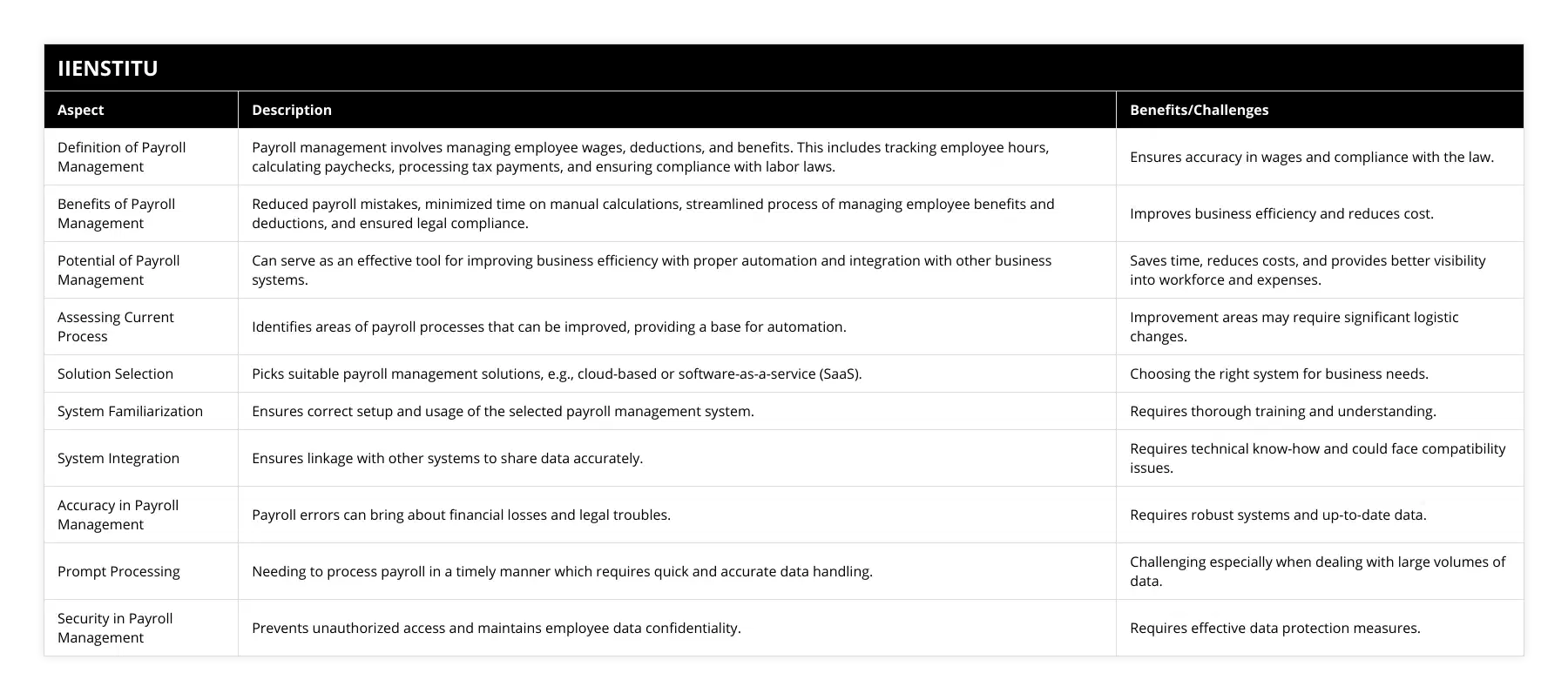
Frequently Asked Questions
What are the benefits of payroll management?
Payroll management is an integral part of any organization, ensuring timely and accurate employee payments. This system helps organizations save time and resources while providing a comprehensive overview of employee payment records. Businesses can benefit from greater efficiency and cost savings by managing payroll efficiently. Here are some of the critical advantages of having a payroll management system.
Reduced Errors
One of the primary benefits of payroll management is that it reduces errors in financial calculations. The system automates calculations for employee salaries, deductions, bonuses, overtime pay, etc., resulting in fewer mistakes and higher accuracy. This reduces the need for manual data entry and eliminates the possibility of human error when dealing with payroll information.
Simplified Compliance
Payroll management systems also simplify compliance with legal requirements related to taxation and labor laws. For example, the system automatically updates tax tables to ensure accurate filing of taxes each year and adheres to local labor laws regarding wages and benefits. This helps businesses stay compliant without any hassle or costly penalties due to incorrect filings or non-compliance with regulations.
Cost Savings
Another significant benefit of payroll management is reduced costs associated with processing paychecks or other forms of payment, such as stock options or bonuses. Automated systems allow businesses to streamline their processes, resulting in lower overhead costs, such as less paper waste and fewer manual labor hours spent manually processing paychecks. Additionally, automated systems help reduce fraud by keeping track of all transactions within an organization's payroll unit, which can result in significant savings over time.
Increased Security
The security associated with automated payroll management systems also provides businesses with peace of mind knowing that their data is safe from potential breaches or malicious actors who may attempt to access sensitive information about employees' salaries or other financial details related to the business's operations. In addition, automated systems provide an additional layer of protection by utilizing encryption technology, which makes it harder for unauthorized personnel to access confidential information stored within these systems without proper authorization from authorized personnel only authorized by the organization that manages it.
Improved Productivity
Finally, a payroll management system can help improve productivity throughout an organization by allowing employees more time to focus on core tasks instead of spending lengthy amounts, ensuring all calculations are accurate when dealing with employee payments manually. Automating mundane tasks like data entry eliminates potential distractions that could impact productivity levels throughout a business's operations.
In conclusion, having a reliable payroll system provides numerous advantages for organizations, including improved accuracy, simplified compliance, cost savings, increased security, and improved productivity. Businesses should consider investing in this type of software if they want streamlined processes when dealing with employee payments.
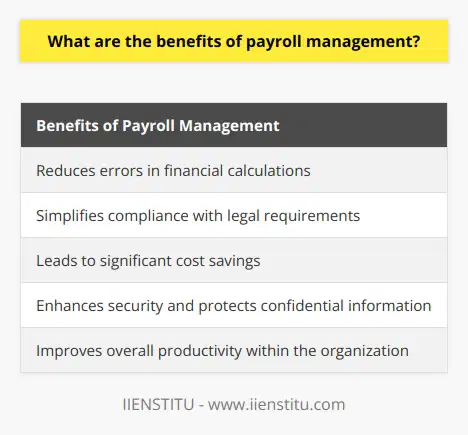
How can payroll management help businesses stay compliant with labor laws?
Payroll management is essential to any business, ensuring compliance with labor laws. Proper payroll management can help businesses comply with labor laws and minimize legal risks.
Understanding Labor Laws
The first step to staying compliant with labor laws is understanding the laws and how they apply to your business. Understanding the federal and state labor laws that apply to your business and what types of activities or practices may violate those laws is essential.
Creating a Payroll System
Businesses should create a payroll system tailored to their needs and labor laws. This system should include a detailed record of employees, their salaries, and any applicable deductions. Additionally, businesses should ensure that they are calculating the appropriate wage rates and withholdings for each employee by the applicable labor laws.
Time and Attendance Tracking
Businesses should also track employee time and attendance to ensure compliance with labor laws. This should include an accurate record of the hours worked by each employee and any overtime or leave taken. This information should be tracked and reported accurately so that employees are adequately paid for their time and the business complies with applicable labor laws.
Tax Compliance
Payroll management can also help businesses stay compliant with tax laws. Employers must ensure that they correctly calculate and report taxes and withhold the appropriate amount from employee paychecks. Additionally, employers must ensure they file and pay taxes on time.
Auditing and Compliance
Finally, businesses should ensure their payroll system is regularly audited to comply with labor laws. This should include a review of employee records, payroll calculations, and any deductions or withholdings. Auditing is essential in ensuring that businesses remain compliant with labor laws and that their payroll system is functioning correctly.
Payroll management is essential to any business, ensuring compliance with labor laws. Proper payroll management can help businesses comply with labor laws and minimize legal risks. Businesses should create a payroll system tailored to their needs and labor laws, track employee time and attendance, ensure tax compliance, and audit their payroll system regularly. This will help businesses comply with labor laws and reduce their legal risks.
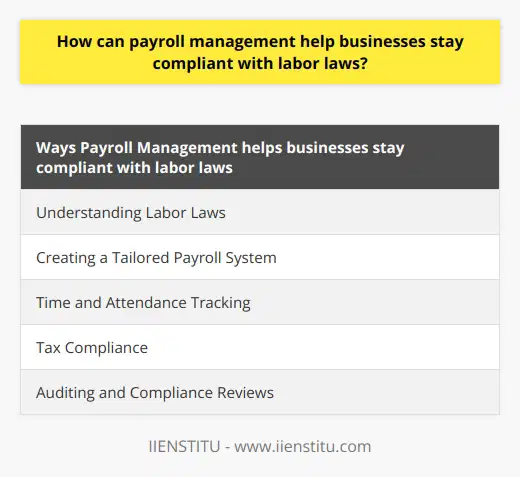
What potential does payroll management have for improving business efficiency?
Payroll management is a critical aspect of any business, and its ability to improve efficiency can play an integral role in the success of any organization. Payroll management involves the tracking and processing employee wages, deductions, bonuses, and other payroll-related activities. By streamlining payroll processes, businesses can improve efficiency by increasing accuracy and reducing time spent on manual labor.
Time Savings
One of the main benefits of payroll management is that it reduces the time spent on manual labor. By automating payroll processes, businesses can save time and money as they no longer need to calculate wages manually or manually update records. Automation also eliminates errors caused by manual data entry or calculations. This can lead to improved accuracy and more efficient processes overall.
Increased Productivity
By streamlining payroll processes with automated systems, businesses can increase their productivity as they now have more time available for other tasks such as marketing or customer service initiatives. Automation also allows businesses to focus on core competencies like strategy development or customer acquisition rather than spending valuable resources on routine tasks like processing paychecks. This leaves more resources available for higher-level activities that can help create a competitive edge in the marketplace.
Cost Savings
Automating payroll processes also helps businesses save money in several ways. Firstly, it reduces costs associated with manual labor, such as hiring additional staff or training employees to perform specific tasks related to payroll management. Additionally, automation can help reduce errors which could lead to legal issues if not addressed quickly enough or accurately enough due to manual labor involved in processing them manually. This cost savings goes beyond just financial savings. It also provides peace of mind for employers with fewer errors associated with their payrolls due to automated systems being used instead of manual labor for data entry and calculations.
Improved Security
Automated systems provide greater accuracy and better security measures than traditional methods used during manual processing when it comes to employee data such as bank accounts or Social Security numbers. Automated systems allow employers to access multiple layers of security protocols when accessing employee information, making it difficult for hackers or malicious actors to gain access easily compared with traditional methods that rely heavily on human error. Furthermore, automated systems can be programmed so that they only allow authorized personnel access when handling sensitive information, providing an extra layer of security against any attempts at fraud through fraudulent activity.
Overall, utilizing automated systems for payroll management has potential benefits across multiple areas: increased productivity, cost savings, improved security, and time savings. In addition, by streamlining payroll processes, businesses can create a more efficient working environment where resources are allocated appropriately according to their values and risks. This ultimately allows organizations greater flexibility in dealing with unexpected situations while optimizing performance over the long run.
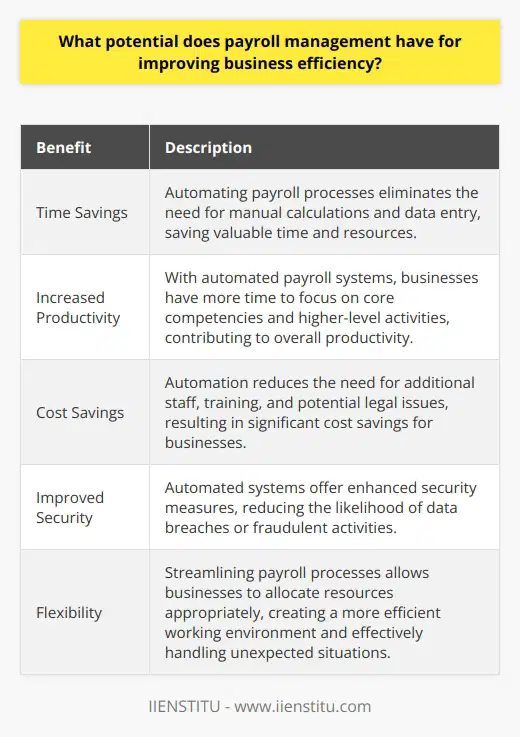
What is the overview of payroll management system?
Overview of Payroll Management System
**Purpose and Function**
A payroll management system is a crucial tool for businesses that effectively manages employee compensation. Its primary function includes processing employee salaries, deductions, and tax withholdings, ensuring timely and accurate payment.
**Components and Features**
Various components constitute a payroll management system, which include employee and payroll data management, time and attendance tracking, tax compliance, and reporting. Essential features like automation, user-friendliness, and regulatory updates ensure the system's efficiency and accuracy in handling payroll processes.
**Integration with Other Systems**
A robust payroll management system seamlessly integrates with other business software, such as human resources, accounting, and time and attendance systems. This integration allows for real-time data sharing, enhancing accuracy and reducing the chances of errors that may arise from manual data entry.
**Benefits of an Efficient System**
An effective payroll management system offers several benefits, such as cost reduction, time savings, improved compliance, and employee satisfaction. Employers can avoid penalties by ensuring timely tax payments, while employees enjoy timely and accurate compensation, boosting productivity and satisfaction levels.
**Selection Criteria and Implementation**
Choosing the appropriate payroll management system depends on various factors, including business size, budget, and regulatory requirements. Implementing the chosen system requires thorough planning, employee training, and testing to ensure its smooth functioning and meeting organizational needs.
In conclusion, a payroll management system is an essential tool for businesses to ensure accurate and timely payment of employee wages and deductions. By embracing its various components, features, and integration capabilities, organizations can reap numerous benefits, including improved compliance, cost savings, and enhanced employee satisfaction.
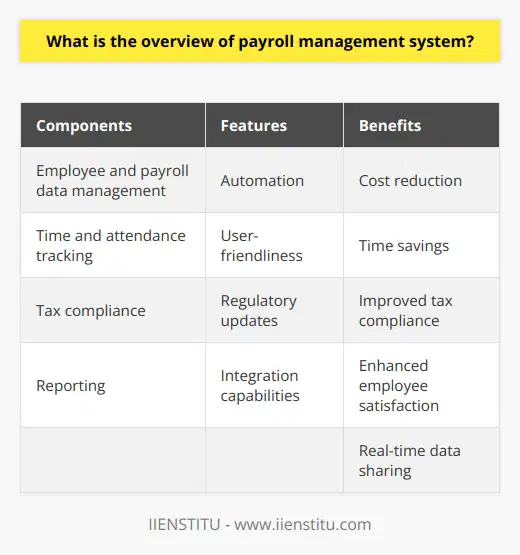
What is the objective of payroll management system?
Objective of a Payroll Management System
Efficient Processing and Distribution
The primary objective of a payroll management system is to facilitate the efficient processing and distribution of employees' salaries, wages, and related financial responsibilities. This comprehensive management system encompasses the accurate calculation of gross pay, deductions, and net pay, ensuring timely and accurate compensation for work.
Compliance with Legal Regulations
Another crucial objective is to maintain compliance with legal regulations and guidelines governing various aspects of payroll, such as tax withholding, payments to government agencies, and reporting requirements. The payroll management system ensures that all employer obligations concerning employee compensation are met, minimizing the risk of legal penalties or financial sanctions.
Record-Keeping and Reporting
The payroll management system also aims to provide reliable record-keeping and reporting, enabling organizations to track payroll-related expenses, monitor budget allocations, and assess employee performance. Detailed and accurate payroll records form an integral part of an organization's financial reporting, influencing overall business strategy and decision-making.
Enhanced Data Security
Data security is a vital objective in payroll management, protecting sensitive employee information and safeguarding financial data. Modern payroll systems employ robust security measures, such as encryption and secure access controls, to ensure that payroll data remains confidential and protected from unauthorized access or manipulation.
Cost-Effectiveness and Time-Saving
An efficient payroll management system saves both time and money, streamlining payroll processes, reducing the possibility of errors, and eliminating the need for manual calculations or adjustments. The automation of various payroll tasks enables HR personnel and administrators to focus on other critical areas of business administration, increasing overall productivity.
Employee Satisfaction
Lastly, a well-managed payroll system contributes to employee satisfaction by ensuring that workplace compensation practices are transparent, timely, and accurate. Employees are more likely to feel valued and motivated when they can trust their employer to process their pay correctly and promptly, fostering a positive work environment and promoting staff retention.
In conclusion, the primary objective of a payroll management system is to provide organizations with a robust, efficient, and reliable means of managing all aspects of employee compensation. By supporting efficient payroll processing, legal compliance, accurate record-keeping, enhanced data security, cost-effectiveness, and employee satisfaction, a payroll management system ultimately drives business success and growth.

What is the future of payroll?
The Future of Payroll: Technological Innovations
One significant development shaping the future of payroll is the integration of advanced technology. Automation, for instance, is expected to streamline the payroll process and increase efficiency in calculations, tax filings, and regulatory compliance. Enhanced accuracy through automated error-checking mechanisms will minimize instances of human errors that often lead to costly consequences for both employees and employers.
Digital Transformation: Cloud-based Solutions
The shift from manual, on-premise solutions to cloud-based platforms is another trend that will likely revolutionize the payroll landscape. Cloud-based systems provide greater accessibility, flexibility, and scalability, making payroll management more seamless and convenient. These platforms also facilitate real-time data updates and analytics, which enable employers to make informed decisions regarding employee compensation and benefit structures.
Global Workforce: Cross-border Payroll Processing
In the face of globalization and the rise of remote working, managing payroll for an international workforce will become more complex. The future of payroll will involve streamlining cross-border payroll processing, overcoming differences in tax regulations, currency conversions, and reporting requirements. The use of specialized software that can cater to multiple countries and languages will be crucial for payroll professionals to navigate the complexities of handling an international workforce.
Role of Artificial Intelligence and Machine Learning
Artificial intelligence (AI) and machine learning will play significant roles in shaping the future of payroll. These technologies will dramatically improve the speed and accuracy of payroll calculations while reducing the need for manual data entry. AI-driven chatbots and voice assistants will also enhance employee support services by answering payroll queries, providing real-time updates, and ensuring compliance with changing regulations.
The Focus on Data Security and Privacy
As payroll becomes increasingly digitized and data-driven, ensuring the protection and privacy of sensitive employee information will be paramount. Employers will need to implement robust cybersecurity measures and invest in technologies like encryption, data masking, and two-factor authentication to safeguard their payroll systems against breaches and unauthorized access. This will be essential not only for maintaining trust with employees but also for adhering to privacy regulations such as the General Data Protection Regulation (GDPR) and safeguarding against potential penalties.
In conclusion, the future of payroll will witness significant transformations driven by technology, changes in workforce dynamics, and regulatory considerations. Automation, digitalization, and data security will be critical in shaping payroll practices, ensuring efficiency, accuracy, and compliance in the increasingly complex world of employee compensation management.
